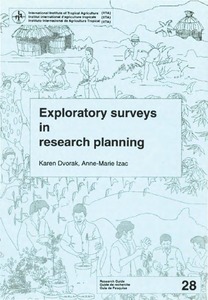| dc.contributor.author | Vayssieres, J. |
| dc.contributor.author | Coulibaly, O. |
| dc.contributor.author | Sinzogan, A. |
| dc.contributor.author | Adandonon, A. |
| dc.contributor.author | Dakouo, D. |
| dc.contributor.author | Dabiré, R. |
| dc.contributor.author | Ouédraogo, S. |
| dc.date.accessioned | 2019-12-04T11:24:30Z |
| dc.date.available | 2019-12-04T11:24:30Z |
| dc.date.issued | 2012 |
| dc.identifier.citation | Vayssieres, J., Coulibaly, O., Sinzogan, A., Adandonon, A., Dakouo, D., Dabire, R. & Ouedraogo, S. (2012). Mango cultivation in Burkina Faso. In S.G. Valavi, K. Rajmohan, J.N. Govil, K.V. Peter and G. Thottappilly, Mango: cultivation in different countries. Houston: Studium Press LLC. (p. 208-229). |
| dc.identifier.isbn | 1-933699-94-9 |
| dc.identifier.uri | https://hdl.handle.net/20.500.12478/4385 |
| dc.description.abstract | Considering the different commodities, the mango production plays a major role in terms of realization of food security and improvement of the livelihood of the rural populations in Burkina. Mango represents about 50% of the fruit production in Burkina Faso and plays an important nutritional role for populations living in rural area as a fruit crop and also as a subsistence crop for family farms. The major mango growing areas are located in the Southwest part providing 75% of the national mango production and the Western-central part of the country, both located in the Sudanian agro-ecological zone (sensu lato). Mango orchards occupy 15,000 ha i.e 75% of the total area occupied by the fruit crops, and annually produce 120,000 tons. Mango is the main crop in Burkina where it covers about 14 000 ha representing 58% of the surface of all perennial crops. The mango production has generated more than 374,483 jobs in Burkina Faso. In terms of income, mango producers earned about 30.4 billion of FCFA and traders 6 billion of FCFA in 2008. The mango value chain is using about sixty units of transformation including an industrial unit of pulp and juice production. In Burkina Faso, the total number of mango cultivars has been estimated to 30. However 7 main cultivars are cultivated. They are Amélie, Kent, Keitt, Valencia, Lippens, Springfels, and Brooks. Kent and Keitt are the two most exported cultivars. Assessments reveal that Burkinabe mango producers are confronted with two main connected phytosanitary problems namely (i) deterioration of fruit quality due to fruit flies, (ii) bacterial black spot (BBS). Mango-infesting fruit flies as Ceratitis cosyra and Bactrocera invadens (Diptera Tephritidae) became the main target pests in Burkina as in other West African countries. Pre harvest diseases in Burkina Faso includes now bacterial black spot (BBS) caused by Xanthomonas campestris pv. mangiferaeindicae causing bacterial canker in Burkina since 2011. Apart from the mangoes exported fresh (conventional, the organic and/or fair-trade certified mangoes), a substantial share of the mangoes is being processed into dried mango, juice and pulp, for domestic and export markets (FAO, 2010). Mango processing contributes to overcoming the hurdle of mango rotting and drains foreign exchanges to the country. The industrial processing of mango started in Burkina Faso in 1980 with the installation of the first drying factories supported by the national government. They are well developed. Three types of value added chains are commonly observed for mango production in Burkina Faso (i) the traditional value chain (fresh mango for local market), (ii) the modern/ urban processing value chain (fresh mango for modern markets or processed mango (dried/juice) for export markets, and (iii) the export value chain (export value chain: fresh/fresh cut). |
| dc.language.iso | en |
| dc.subject | Mangifera Indica |
| dc.subject | Income Generation |
| dc.subject | Subsistence |
| dc.subject | Economic Importance |
| dc.title | Mango Cultivation in Burkina Faso |
| dc.type | Book Chapter |
| dc.description.version | Peer Review |
| cg.contributor.crp | Grain Legumes |
| cg.contributor.affiliation | Centre de Cooperation Internationale en Recherche Agronomique pour le Developpement |
| cg.contributor.affiliation | International Institute of Tropical Agriculture |
| cg.contributor.affiliation | Université d'Abomey Calavi |
| cg.contributor.affiliation | Institute of the Environment and Agricultural Research of Burkina Faso |
| cg.coverage.region | Africa |
| cg.coverage.region | West Africa |
| cg.coverage.country | Burkina Faso |
| cg.authorship.types | CGIAR and developing country institute |
| cg.accessibilitystatus | Limited Access |
| local.dspaceid | 100635 |

